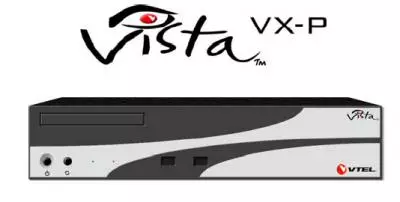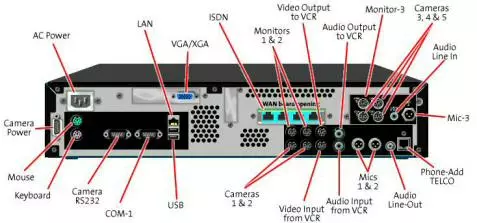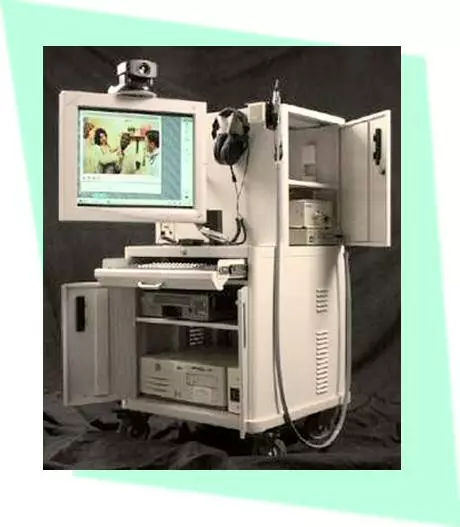|
VTEL Vista™ VX-P media station
VTEL’s most capable videoconferencing endpoint, the Vista VX-P is a high-performance, PC-based codec. The Vista VX-P includes an expanded input/output capability allowing up to five video sources and three microphones to be connected making it a highly flexible solution for telemedicine
System comprises:
- Videoconferencing codec mountable in standard 19-inch rack or on a shelf
- Integrated Windows® PC with DVD drive
- 3 available USB ports for ease of expansion
- Built-in input/output expansion board to support 5 video sources/cameras and 3 microphones
Presentation Tools
- Pen Pal Graphics™ for slide creation, sending, and capture (supports Microsoft® PowerPoint)
- SmartView™* hands-free slide sending software for use with any document camera
- VCR optional (simultaneous playback and record with 2 VCRs)
- Document camera optional
Data Collaboration Tools
- Integrated application sharing featuring Microsoft® NetMeeting
- Integrated T.120 support
- In-band file transfer
Codec Features
- Intel® Pentium® microprocessor
256 MB RAM
Single 20 GB hard drive
DVD drive
3 external USB ports
Com 1 serial port
- PC functionality available in or out of a call
Remote Management
- SmartVideoNet Manager™ client included for SNMP remote management
- Remote software update capability
User Interfaces
- QuickTouch wireless remote control unit with integrated wireless keyboard and mouse
- Full sized wireless keyboard with integrated mouse included with HealthStation 2004
Video Communications
- H.261 and H.263
- FCIF - 352 x 288, QCIF - 176 X 144
- Frame rate up to 30 frames per second
- Dual monitor support
- Monitor output:
Single monitor – VGA, XGA, or S-video
Dual monitor – 2 S-video and 1 VGA/XGA, or 2 S-video
VCR (record) output: S-Video NTSC or PAL format
- Picture in picture
- Far end camera control in H.320 and H.323
- Third S-video output for external control or monitoring systems
|


Camera Inputs
- Includes one PTZ camera, NTSC or PAL broadcast, Auto focus,
Auto white balance, 10x optical zoom, 40x digital zoom, f 3.1 – 31 optical, f 1.8 – 2.9 digital, Pan ±100°, Tilt ± 25°
- 5 S-Video inputs with PTZ control
- 1 VCR (playback) input: S-Video
Graphics Resolution
- Slide capture in JPEG format, 704 pixels x 576 lines x 24 bits
- H.261 Annex D, 4FCIF
- XGA graphics display (1024 x 768)
Audio Communications
- G.722, G.711, and G.728
- Full duplex, adaptive acoustic echo canceling, noise
suppression, and automatic microphone level adjustment
- Integrated multimedia sound
- Audio outputs:
Line level output, VCR (record) output
- Audio Inputs:
3 microphone inputs, VCR (playback) input
1 Aux line input
- Microphone: 1 omni-directional microphone standard
- 1 integrated telephone input for telephone add- in**
Communications Standards
- ITU-T H.320 and H.323
Communications Interface Options
- IP 10/100 LAN card for H.323
- Quad BRI IMUX, RJ45 (S/T) optional
- T1/E1, PRI, or DDM H.320 card optional
- Wireless LAN card, IEEE 802.11b, 11Mbps optional
Transmission Rates
- 2 x 56/64 Kbps, 56 - 1920 Kbps H.320 (optional
communications interface required)
- 56 - 1920 Kbps H.323
Physical
- Component dimensions (W x H x D):
17.37” x 3.4” x 13” / 44.12cm x 8.64cm x 33.02cm
- Weight: 18 pounds / 8.28 kg
Power Requirements
- Line voltage: 115V / 230V AC, auto sensing power supply
- Power consumption: 585/645 W nominal
- Heat dissipation: 1996/2200 BTU/hour
Operating Environment
- Temperature: 50 - 90°F / 10 - 32°C
- Humidity: 10 - 80% non-condensing
Warranty
- 36-month hardware and VTEL software warranty included
|




